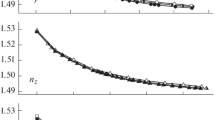Summary
It is suggested that the birefringence of crystalline bodies can be explained as arising from the existence of polarised electronic transitions, so that the probability of transition is different for different directions of the incident electric vector. As a result, in the dispersion formulæ for the three principal refractive indices of a biaxial crystal, the oscillator-strengths will be different, although the dispersion frequencies are the same. The application of the idea to the cases of calcite and aragonite (two strongly birefringent crystals) enables one to construct dispersion formulæ involving three ultra-violet frequencies at 1535, 1000 and 500 Å.U. The formulæ, which fit the dispersion data for both rays of calcite from 0·2 to 3 μ, show that a large part of the birefringence arises from the large anisotropy in the strength of the nearest ultra-violet frequency at 1535 Å.U. A similar result is also found for aragonite.
The dispersion formulæ are also successful in explaining the thermooptic behaviour of both calcite and aragonite, when they are utilised in the author’s theory of thermo-optic behaviour, which has so far been applied only for isotropic solids. For anisotropic solids, an additional principle has to be used,viz., that, while the total oscillator strength does not alter with temperature, the individual strengths along the three principal directions can change, resulting in a mutual transfer. It is suggested that this transfer is related to the differences in thermal expansion along the three directions, which finds some support in the case of aragonite. A physical explanation of the transfer can be found, wholly or partly, in the tilting oscillations of the CO3 ion.
The theory is successful in explaining the remarkable fact that, whiledn/dt for both indices of calcite is positive, that for all the indices of aragonite is negative, the difference being attributable to the much larger coefficient of thermal expansion of the latter.
Similar content being viewed by others
References
Bragg, W. L.Proc. Roy. Soc.,A, 1924,105, 370.
BornAnn. d. Phys., 1918,55, 177.Enz. d. Math. Wiss., 1922,5, pt. 3, 529.
EwaldAnn. d. Phys., 1916,49, 1, 117.
Hilsch and PohlZeits. f. Phys., 1930,59, 812.
KopcewiczJourn. de Phys., 1937,8, 6.
Kurtz and WardJourn. Frank. Inst., 1937,224, 697.
LiebischPhysikalische Krystallographie, 1891.
Liebisch and RubensSitzber. Preuss. Acad., 1919, 198.
MarbachDiss. Leipzig, 1913.
MicheliAnn. d. Phys., 1902,7, 772.
MühlheimsZeits. f. Kryst., 1888,14, 202.
NedungadiProc. Ind. Acad. Sci. A, 1939,8, 397.
NyswanderPhys. Rev., 1909,28, 291.
OffretBull. Soc. Min., 1890,13, 405.
Ornstein and WentPhysica, 1935,5, 503.
PulfrichWied. Ann., 1887,30, 496.
Radhakrishnan, T.Proc, Ind. Acad. Sci., A, 1947,25,a 265,b 382.
Ramachandran, G. N.Ibid.,, 1947,25,a 266,b 280,c 286,d 375,e 481,f 498.
ReedAnn. d. Phys. u. Chem., 1898,65, 734.
RudbergPogg. Ann., 1829,17, 16.
Schneider and O’BryanPhys. Rev., 1937,51, 293.
ScouvartBull. Acad. Belg., 1912, 97.
Sosman “Properties of Silica”, 1927, Ch. XXIV, p. 671.
VenkateswaruluProc. Ind. Acad. Sci. A, 1942,16, 45.
Author information
Authors and Affiliations
Additional information
(Communicated by Sir C. V. Raman,kt., f.r.s., n.l.)
Rights and permissions
About this article
Cite this article
Ramachandran, G.N. Birefringence of crystals and its temperature-variation. Proc. Indian Acad. Sci. 26, 77 (1947). https://doi.org/10.1007/BF03170953
Received:
DOI: https://doi.org/10.1007/BF03170953




